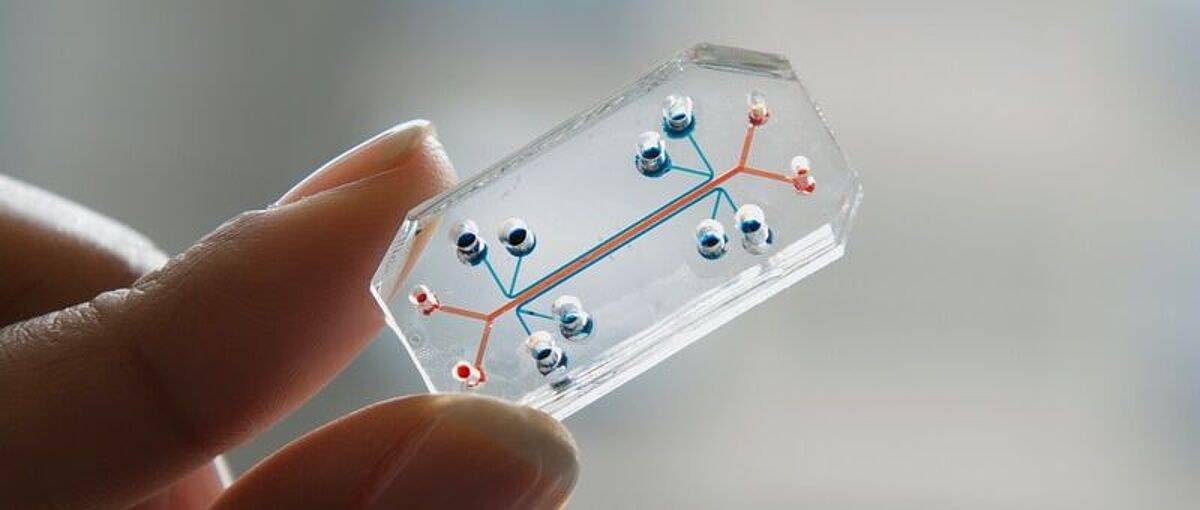
With the potential to perform almost any laboratory-based process on a miniaturized scale, lab-on-a-chip systems are being developed for applications spanning basic research through to advanced clinical diagnostics.
What is lab-on-a-chip technology?
Lab-on-a-chip technology uses microfluidics to combine multiple laboratory processes into a single miniaturized system, usually no more than a few square centimeters in size. Specifically, a network of microchannels is assembled onto a suitable substrate, along with various components for manipulating the flow of liquids (e.g., pumps, valves, and electronics), and the resultant chip is used for conducting biological and biochemical analyses. This approach allows researchers to perform highly parallelized experiments using very low sample volumes, essentially replicating the capabilities of a fully functional laboratory at the microscale.
A brief history of lab-on-a-chip technology
The first lab-on-a-chip device, a gas chromatograph, was reported in 1979 by researchers at Stanford University1. It consisted of a sample injection valve, a 1.5 m long separation column, and a thermal conductivity detector, which were fabricated onto silicon substrates, and boasted a 3-fold size reduction compared to conventional laboratory instruments.
Subsequent research focused mainly on silicon-based fabrication of micropumps, microvalves, and chemical sensors, leading to a breakthrough in 1990 when a miniaturized total chemical analysis system (µ-TAS) was described2. With the ability to perform sample pretreatment, separation, and detection in a single device, the µ-TAS paved the way for a broad range of lab-on-a-chip applications to be developed.
Lab-on-a-chip technology has since been adopted for molecular biology (e.g., DNA and RNA sequencing), proteomics (e.g., ELISA and electrophoresis/mass spectrometry-based analyses), and cell biology applications (e.g., high-speed flow cytometry and cell sorting), as well as for chemical synthesis at the microscale. In addition, organ-on-a-chip technology has evolved as a means of modeling conditions of health and disease.
Advantages and limitations of lab-on-a-chip technology
A major advantage of lab-on-a-chip technology is that it requires very little sample material, often down to picoliter amounts, which both reduces the burden on patients and minimizes reagent use. Lab-on-a-chip technology also benefits from faster analysis times and tighter process control than established methods as the microscale environment allows for quicker diffusion of chemicals and heat and is more easily regulated.
Other advantages of lab-on-a-chip technology include its capacity for high-throughput analysis, which results from being able to perform multiple experiments on the same chip; its reduced risk of human error, due to very little hands-on time being required; and its portability, which presents opportunities for use in remote locations lacking access to laboratory facilities.
On the flipside, lab-on-a-chip technology is still in its infancy, with very few devices yet ready for commercialization. Different substrates are being investigated as alternatives to silicon (including glass, elastopolymers, thermoplastics, paper, and digital microfluidics), and the impact of factors such as surface roughness, capillary forces, and non-specific interactions on data quality is being explored. Additionally, there is a need to design more robust, cost-effective manufacturing processes, as well as to develop and implement appropriate regulatory measures. The latter will become especially important as more diagnostic lab-on-a-chip tests reach the market.
Recent applications of lab-on-a-chip technology
Lab-on-a-chip technology is being considered for such a vast array of applications that it would be impossible to cover all of them here. However, some notable examples include an FDA-authorized device to screen newborn blood for four rare lysosomal storage disorders known to cause organ damage, neurological disability or death if not detected in a timely manner, and an automated version of cellulose acetate electrophoresis (CAE) that can diagnose sickle cell disease in as little as 8 minutes compared with several days using the original CEA method3,4.
Disease modeling applications of lab-on-a-chip technology include the development of a human lung ‘small-airway-on-a-chip’ using epithelial cells from individuals with chronic obstructive pulmonary disease (COPD), which allows for analysis of inflammation and drug responses in vitro, and the establishment of a ‘heart-on-a-chip’ microdevice based on human induced pluripotent stem cells (iPSCs) for evaluating cardiac function5,6. With further advances in lab-on-a-chip technology being reported, it will be interesting to see where the field goes next.
Supporting your research
LubioScience represents some of the most trusted brands in research and works closely with our partners to offer a diverse selection of high-quality products. Contact us today to discuss how we can support your project.
References
- https://ieeexplore.ieee.org/document/1480369
- https://www.sciencedirect.com/science/article/abs/pii/092540059080209I
- https://www.fda.gov/news-events/press-announcements/fda-permits-marketing-first-newborn-screening-system-detection-four-rare-metabolic-disorders
- https://sicklecellanemianews.com/news/hemex-awarded-3m-bring-gazelle-diagnostic-test-us/
- https://www.nature.com/articles/nmeth.3697
- https://www.nature.com/articles/s41598-020-76062-w
